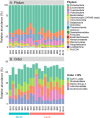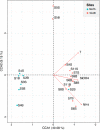Prokaryotic Diversity and Distribution Along Physical and Nutrient Gradients in the Tunisian Coastal Waters (South Mediterranean Sea)
- PMID: 33335519
- PMCID: PMC7735998
- DOI: 10.3389/fmicb.2020.593540
Prokaryotic Diversity and Distribution Along Physical and Nutrient Gradients in the Tunisian Coastal Waters (South Mediterranean Sea)
Abstract
Prokaryotes play an important role in biogeochemical cycling in marine ecosystems, but little is known about their diversity and composition, and how they may contribute to the ecological functioning of coastal areas in the South Mediterranean Sea. This study investigated bacterial and archaeal community diversity in seawater samples along the Tunisian coast subject to important physicochemical disturbances. The 16S amplicon sequencing survey revealed higher prokaryotic diversity in the northern Tunisian bays than in southeastern waters (Gulf of Gabès). The major taxonomic groups identified in all samples were Alphaproteobacteria (40.9%), Gammaproteobacteria (18.7%), Marine Group II Euryarchaeota (11.3%), and Cyanobacteria (10.9%). Among them, the relative abundance of Alteromonadales, Prochlorococcus, and some clades of Pelagibacterales (SAR11) significantly differed between the northern and the southern bays, whereas no difference was observed across coastal waters in the archaeal Candidatus Poseidoniales (MGII), Synechococcus, and Pelagibacteraceae (SAR11 clade Ia), for which no relationship was observed with the environmental variables. Both Pseudoalteromonas and Alteromonas levels increased with the increasing salinity, density and nutrients (NH4 + and/or PO4 3-) gradients detected toward the southern waters, while the SAR11 clades Ib and IV and Prochlorococcus, decreased in the shallow, salty and nutrient-rich coastal waters of the Gulf of Gabès. Rhodobacteraceae was positively correlated with Synechococcus and chlorophyll levels, suggesting a relationship with phytoplankton biomass. The present study provides the first insights into planktonic prokaryotic community composition in the South Mediterranean Sea through the analysis of Tunisian seawaters, which may support further investigations on the role of bacterioplankton in the biogeochemistry of these ecosystems.
Keywords: Gulf of Gabès; Tunisia; archaea; bacteria; bacterioplankton; diversity; seawater.
Copyright © 2020 Quéméneur, Bel Hassen, Armougom, Khammeri, Lajnef and Bellaaj-Zouari.
Conflict of interest statement
The authors declare that the research was conducted in the absence of any commercial or financial relationships that could be construed as a potential conflict of interest.
Figures







References
-
- Allers E., Gomez-Consarnau L., Pinhassi J., Simek K., Gasol J. M., Pernthaler J. (2007). Population dynamics of Alteromonas and Roseobacter in marine mesocosms after substrate and nutrient manipulations. Environ. Microbiol. 9 2417–2429. - PubMed
-
- Alonso-Sáez L., Balagué V., Sà E. L., Sánchez O., González J. M., Pinhassi J., et al. (2007). Seasonality in bacterial diversity in north-west Mediterranean coastal waters: assessment through clone libraries, fingerprinting and FISH. FEMS Microbiol. Ecol. 60 98–112. 10.1111/j.1574-6941.2006.00276.x - DOI - PubMed
-
- Amils R. (2014). “Nanoarchaeota,” in Encyclopedia of Astrobiology, eds Amils R., et al. (Heidelberg: Springer; ).
-
- Anandan R., Dharumadurai D., Manogaran G. P. (2016). “An introduction to actinobacteria,” in Actinobacteria-Basics and Biotechnological Applications, eds Dhanasekaran D., Jiang Y. (Rijeka: Intechopen; ), 3–37.
-
- Ayata S. D., Irisson J. O., Aubert A., Berline L., Dutay J. C., Mayot N., et al. (2018). Regionalisation of the Mediterranean basin, a MERMEX synthesis. Progr. Oceanogr. 163 7–20. 10.1016/j.pocean.2017.09.016 - DOI
LinkOut - more resources
Full Text Sources

